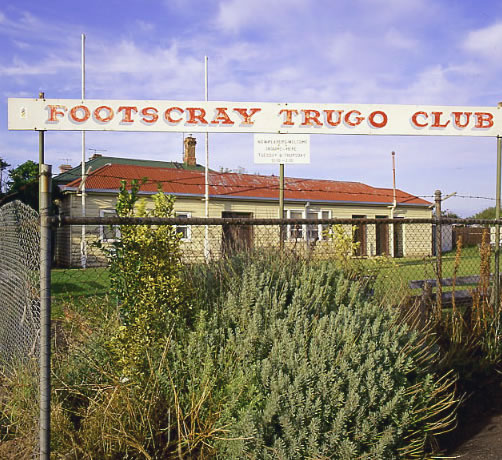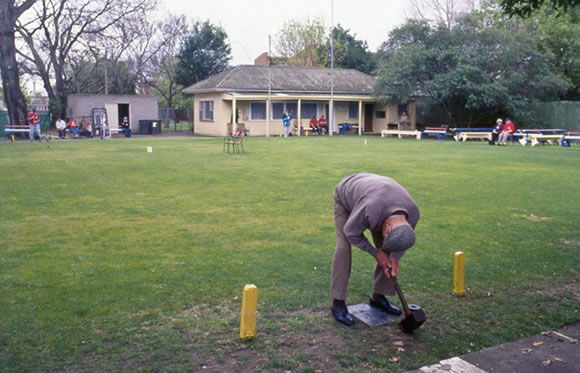Trugo |

is a sport invented in the railway repair workshops of Newport in the Western suburbs of Melbourne by railway workers in the 1920s.
There are only 2 "games" that can be claimed to have been invented in Melbourne.
Trugo like Australian Rules Football is one of Victoria's few indigenous sports. While Aussie rules has become a national sport, Trugo is only played in Victoria. It is still played in the suburbs every week and apart from it's players, most people have never heard of it.
Trugo is a sport invented in the railway repair workshops of Newport in the Western suburbs of Melbourne by railway workers in the 1920s.
Played outdoors on a green similar to that used for Lawn bowls (90 feet / 27.4 meters in length for men, 70 feet / 21.3 meters for women), the objective of the game is to score goals or points by striking a rubber ring (wheel) with a mallet though a pair of goal posts.
The player stands on a rubber mat and is facing away from the goals, feet either side of the wheel. The short handled mallet is swung between the player's legs to strike the wheel ('tunnelling style'). The player's opponent ensures that the wheel is safely contained by collecting it in a canvas bag attached to a long pole once the wheel has passed the goal line.
The players swap roles after four wheels have been struck by the first player. Each player has 24 shots, 12 from each end. The player or team with the most goals at the end of the playing period is declared the winner.
The sport is played by both men and women; the women's version of the game traditionally has the player strike the ring while standing to one side ('side sweeping style'), and is known as GoTru.

The principal Trugo clubs are Brunswick, Footscray, Port Melbourne and Sandridge.
"Tunneling the wheel"OR "Shooting the ring"?
You must be playing the uniquely Australian (and Victorian) sport of TRUGO, a hybrid of LAWN BOWLS, CROQUET & WOODCHOPPING.
Trugo is played throughout Melbourne from August through to April. Men play on Thursdays, women on Saturdays.
The Age Digital Edition: Give it a trugo: bizarre sport a hit again
It's described by some as "backwards industrial croquet" .
If that sounds odd, the reality of the little-known sport of trugo is more so. The players face backwards, using a wooden mallet to hit a rubber "ring" between their legs. The ring hurtles across a grass court towards a goal. Players need to get out of the way if they value their ankles.
Each player has 24 shots. Every hit that goes through the goal gets one point. The team with the highest score wins. Invented by Newport railway workers in 1925, trugo is enjoying a bit of a renaissance in Melbourne, with two clubs being revived and a wave of younger players invigorating the sport.
In the early days, railway workers took trugo from the railyards to Melbourne's parks when they retired. They were soon joined by other friends and at least 15 clubs sprang up in the inner suburbs.
By 2009 the sport seemed doomed, with an ageing membership and just six clubs remaining. Footscray, the city's second-oldest club, couldn't field a team of eight and decided to fold.
But the potential of its 30-metre grass court in Seddon wasn't lost on the area's younger residents.
Stuart and Liana Lucca-Pope , owners of Footscray's Littlefoot Bar, often passed the Buckley Street club, and posted on social media for anyone interested in helping revive it.
Justin Mansfield , 49, was keen to connect with the community and its heritage. He's one of eight people who responded to the post.
The group was given equipment from other clubs and had the rings made from a trugo mould in a Tullamarine factory.
Footscray now has 28 members and two teams. They have nicknamed one team the Doughnuts, slang for the doughnut-sized rings trugo players hit - and a homage to the Olympic Doughnuts van that stood next to Footscray railway station.
The club's second team, the Gumnuts, is named after a tree shading their court. Members now hope the local council will renovate the boarded-up clubhouse.
Mr Mansfield said the key to trugo was focus rather than strength.
"If you just stand up and bash away, you're probably not going to get the best result," he said.
"It's a bit meditative: the whole routine you go through when you have a shot is very deliberate: 'Put my feet down, centre my shot, breathe, pause, take my shot' ."
Hipsters have seized on trugo as an even cooler game for parties and work functions than lawn bowls.
Melbourne's trugo league now has seven clubs fielding nine teams. The Ascot Vale club has also been resurrected, and there's interest for revived clubs in Preston and Reservoir.
Footscray's was the first purposebuilt trugo court when it opened in 1940. On Sunday, the club will celebrate the rink's 80th birthday with a Gumnuts versus Doughnuts match, followed by a "come and try" session. Mr Mansfield says members, many aged in their 30s and 40s, are "gently nudging the world of trugo into the 21st century" .
Kate Randall, 41, from Seddon, joined the club two years ago. She doesn't consider herself a sporty person but finds trugo "not very stressful or difficult and not terribly structured. It's just really laid-back ."
She loves a sport with no running or catching. "It's like the opposite of netball. You can play it with a cold drink," she said.
Source: The Age Digital Edition: Give it a trugo: bizarre sport a hit again
This article is from the February 13, 2020 issue of The Age Digital Edition. To subscribe, visit https://theage.digitaleditions.com.au/.
Carolyn Webb
❊ Web Links ❊
➼ Trugo
➼ Connecticut eXtreme Croquet Society
➼ Trugo From Wikipedia
➼ Invented in Melbourne
❊ Also See... ❊
➼ Carolyn Webb
➼ Trugo | Victorian Trugo Association
Disclaimer: Check with the venue (web links) before making plans, travelling or buying tickets.
Accessibility: Contact the venue for accessibility information.
Update Page








